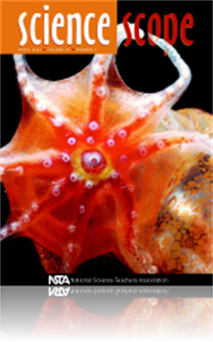All Resources
Journal Article
The difference between luminescence and incandescence seem simple enough concepts to teach. But to help students develop conceptual understanding, thi...
Journal Article
Idea Bank: Tips and techniques for creative teaching
The Idea Bank provides tips and techniques for creative teaching, in about 1,000 words. This month’s Idea Bank features creative teaching techniques...
Journal Article
Reflections on Earth—Remote-Sensing Research from Your Classroom
The Smithsonian Institution, with support from Honda, has developed a program entitled Reflections on Earth to provide resources for remote-sensing ed...
Journal Article
Technology permeates today’s society, but history also contains rich examples of technology as “a way of adapting.” The Egyptians’ approach to...
Journal Article
Online Concept Maps: Enhancing collaborative learning by using technology with concept maps
In the early 1990s, the University of West Florida and IBM Latin America investigated establishing telecommunication links among schools. This arrange...
Journal Article
Adding Math to Biology: Teaching the mathematical basis of evolutionary biology
Without a mathematical understanding of evolutionary theory, we leave students defenseless against shallow arguments and pseudoscience. In this activi...
Journal Article
Examining Language To Capture Scientific Understandings: The Case of the Water Cycle
As teachers of science, we need to keep in mind that thought and language are intricately related. Linguistic approximations, errors, and misses may b...
Journal Article
Commentary: Matchmaker, Matchmaker
An opinion piece about matching and how the pleasure of matching can be found in science class....
Journal Article
Editor's Corner: Convention Fever
The Science Teacher’s editor shares thoughts on the current issue....
Journal Article
Skeptical Science: Teaching students how to critically evaluate unusual claims
Should science teachers discuss the legitimacy of astrology, extrasensory perception (ESP), UFOs, touch therapy, cloning dinosaurs, or any other unusu...
Journal Article
Games Students Play: Teaming up in physics class leads to cooperative learning
The case for motivating students through cooperative learning has been made and supported throughout the last two decades. Two well-known cooperative ...
Journal Article
Good teachers continually plan learning experiences to help young children make connections within and among areas of study (Zemelman, Daniel, and Hyd...
Journal Article
When a Hypothesis is <em>Not</em> an Educated Guess
The terms prediction and hypothesis are often used interchangeably, yet one term means to think about what might happen and the other means to think a...
Journal Article
Dissect Your Squid and Eat It Too!
Studying an organism that lives in the ocean lends itself to many multidisciplinary studies, such as writing poetry about sea creatures, graphing fish...




